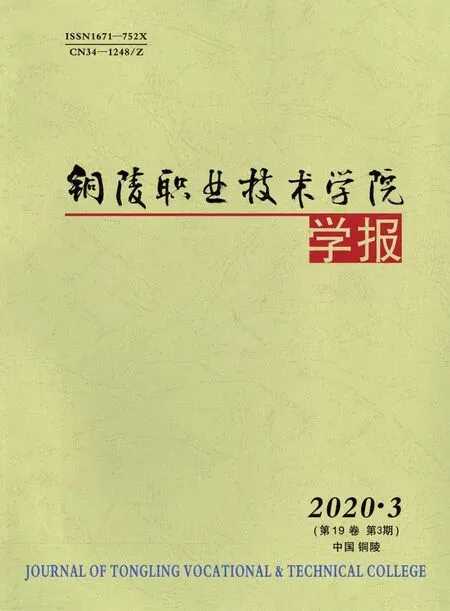“产出导向法”在学术英语教学中的应用及建议
蒋慧丽
(浙江工业大学,浙江 杭州 31004)
1 引言
我国外语教学实践中普遍存在的一个现象是“重课本、轻应用”,课堂教学以课文为中心。“产出导向法”(Production-Oriented Approach,POA)是北京外国语大学中国外语与教育研究中心团队创建、经过十多年发展的教学法理论[1-5],借鉴国外外语教学理论与实践的精华,旨在克服外语教学中 “学用分离”的弊端。迄今为止已有不少教学一线的老师在自己的教学实践中采用“产出导向法”[6-9],汇报了教学成果,并对该理论的具体环节作出辩证反思[10-11]。
目前已发表的文献中,“产出导向法”多用于大学英语口语、写作等单个语言技能的教学实践[12]。本研究将“产出导向法”应用于《通用学术英语》课程,探讨该教学法的实际效果,并对该理论的具体环节提出建议。
2 教学实践
2.1 背景介绍
本研究以杭州市某综合性大学大一第二学期的学生作为研究对象,授课班级为选课班,学生来自各个专业,共36人。所学课程名称为《通用学术英语》,其教学目标是培养学生跨学科的学术共核能力、提高学术英语的应用与交流能力。
该课程的教学安排围绕七项核心产出技能展开,分别是如何下定义及介绍研究背景(How to define and contextualize)、如何区别描述和分析(How to differ between description and analysis)、如何形成一个论点并用论据支撑 (How to develop an argument and support)、如何引用(How to cite)、如何比较相似点和不同点 (How to compare and contrast)、如何总结(How to summarize)、如何结尾(How to draw a conclusion)。
2.2 课堂授课示例
教师在设计课堂教学时,遵照“产出导向法”的教学流程,一般按照“产出驱动环节”、“输入促成环节”、“评价环节”三个步骤循环进行。
以 “如何下定义及介绍研究背景”主题的一次45分钟的课为例。
(1)产出驱动环节
教师布置具有交际语境的产出任务:用一个长句向其他学科的人介绍自己的学科。
学生尝试性完成产出任务:用口头表达或书面表达的形式进行产出,同时意识到自己在做这项任务时对词汇、句式、学术表达规律掌握的不足之处。
学生产出举例(保留原来的语言错误)如下:
1)Architecture is about designing buildings.
2)Software engineering is part of computer science,which designs and updates softwares.
(2)输入促成环节
教师提供恰当的输入语料(讲义、视频片段),让学生讨论总结“下定义”时英语句子的几个主要构成部分。
输入材料举例如下:
Economics is a social science concerned chiefly with description and analysis of the production,distribution,and consumption of goods and service.
Physics is a science that deals with the nature and properties of matter and energy.
Astronomy is a branch of scientific study primarily concerned with celestial objects inside and outside of the earth’s atmosphere.
Material science is a branch of science that deals with the structure,properties,and processing of materials,especially with regard to theirpotential usefulness.
教师引导学生小组讨论,学生发言总结出“下定义”常见的构成要素:
1)term;category;simple words to illustrate the subject
2)nature of the term;usage;characteristics
3)assertive sentence structure;properties;details
4)the class it belongs to;functions;some important details
5)category;what it deals with;something relevant
6)content;nature;function
7)research object;characteristics;scope of application
8)subject classification;features;function
教师基于学生的分析总结共同点,向学生提供“什么样的定义是好的定义”、“学术语境中为什么要学习如何下定义”的输入材料。
1)What is a definition?
A definition is a statement which captures the meaning,the use,the properties,the function and the essence of a term,a thing or a concept.
It is a formal attempt to answer the question:“what is it?”
Defining things or concepts in a clear way is extremely importantin academic communication and helpsto avoid misunderstandingsorconfusions.
2)What are the qualities of a good definition?
A formaldefinition containsthree parts:the term or concept to be defined;the class it belongs to;and its differentiating features.
For example,inductive reasoning is the process of recognizing or observing patterns and drawing a conclusion.
A good definition should be concise and have a logical pattern.
3)Why is it necessary to learn how to define in an academic setting?
Most physical objects have a definition that most people agree on.That means the definition of most physical objects does not change from person to person.You do not need to define them unless you are trying to give them new meanings.
However,a clear definition is required for abstract concepts because the definition may change from person to person.
To be specific,there are several situations when a definition should be given.
One,when your writing contains a term that may be key to audience understanding and that term could likely be unfamiliar to them.
Two,when a commonly-used word or phrase has layers of subjectivity or evaluation in the way you choose to use it.
Three,when you want your readers or audience to have a new way of understanding things or concepts.
In your academic communication,it is of great importance that you define the key concepts,theories,and technical terms clearly.
基于教师提供的语料输入和分析,学生修改产出驱动环节的产出任务,两者的差异即进步的表现。举例如下:
1)Architecture is the art and practice of designing and building structures,especially those for humans to inhabit.
2)Software engineering is a detailed study of engineering to the development of software.
(3)评价环节
学生互评:四人一组互相交流产出任务,评出最理想的一份作品和最有待改进的一份作品。
教师评价:点评优秀的产出作品是否确实高质量,为有待改进的作品提供反馈意见。
3 讨论
3.1 “产出导向法”的优势
(1)“产出导向法”有助于帮助学生了解学术场合通用的学术表达技能。
大类招生的本科生大一第一学期只上过少数几门专业大类的基础课,对各自专业领域的研究流派、主要研究方向还不太清楚,对学术场合下如何得体、准确地表达缺乏认识,对通用学术英语到底学什么也不清楚。
“产出导向法”在产出驱动环节,通过教师布置具有交际语境的产出任务,一方面为激发学生学习欲望做准备,另一方面逐步构建学术场合通用的学术表达技能体系。教学的推进在学生尝试性产出任务、教师提供输入语料、教师发挥“脚手架(scaffolding)”作用进行评价、学生互评的递进过程中帮助学生提高学术交流当中的学术共核能力。
(2)“产出导向法”始于产出任务,终于产出任务,能有效改进学生的英语应用能力。
教学以产出任务作为起点,学生尝试性完成产出任务后能明确产出任务的意义及自身的不足,会更积极主动地为完成产出任务而进行输入性学习。在输出驱动的条件下,适时提供能够促成产出的恰当输入能帮助学习中取得更好的学习效果。在学生互动的交流基础上,恰当的输入材料能起到“专家引领”的作用,将产出水平推向一个新高度。
3.2 对“输入促成环节”的思考
在“产出导向法”中,“输入促成”对产出质量发挥着关键作用。文秋芳(2017b)提出“促成有效性标准”,包含“渐进性”、“精准性”、“多样性”三个维度[13]。“渐进性”指将输入促成材料设计成循序渐进的系列促成活动,为学生搭建脚手架;“精准性”指要对接产出目标,提供实现产出目标所需的内容、语言和语篇结构;“多样性”指输入语料的多样性及教学活动的多样性。
邱琳(2017,2019)在“促成有效性标准”的基础上对促成环节进行了辩证研究[10-11],认为学生能自如使用某一项目标语言,但对另一些目标语言持回避态度,根本原因在于产出困难还未被有效应对,即促成还需清楚界定产出困难。邱琳(2019)修正了文秋芳的“精准性”维度,增加了“应对产出困难”这一条件[11]。

注:“精准性”内涵的扩展,来自邱琳(2019)《“产出导向法”促成环节的辩证研究》
尽管修正后的“精准性”维度对输入促成语料的选择有一定参考意义,笔者从自身的教学实践中发现,输入语料不仅要精准,还要提供使用的语境,即增加“语境化”维度。
以第二部分的 “如何下定义”课堂教学实践为例,经过产出驱动、输入促成、评价环节后,学生基本掌握规范地下定义技能,但是对什么时候需要用到下定义,什么语境下需要详细地下定义、什么时候需要分析该定义与其他定义的全部还不明白。究其原因,教师提供的输出促成语料只截止了“下定义”这个关键句子,没有提供这个句子在什么样的段落当中、这个段落的表达目的是什么等重要信息。
增加“语境化”这个维度的“促成有效性标准”,能够更好地发挥输入性语料的脚手架功能。
例如针对“如何下定义”这个学术技能可以使用下面这个输入性语料。
Mobile learning (m-learning),which is defined as e-learning using mobile devices such as smart phones,personal digital assistants and tablets,allows learners to learn anywhere and anytime.It is an effective component of learning as today’s learners are mobile and frequently utilise mobile devices to study on the move.Thiscan clearly affecttheir learning experience by making ubiquitous learning possible.
(Source:Karimi,S.2016.Do learners’characteristics matter?An exploration of mobile learning adoption in self-directed learning.Computers in Human Behavior,63:769-776.)
这个语料不仅能体现一个好的定义的三个构成要素:专业术语term(mobile learning)、所属类别class (e-learning)、区分其他的特征differentiating features(using mobile devices...),还能帮助读者明白为什么在这里要先介绍mobile learning,以及为什么有必要解释mobile learning的影响力。这个语境包含文献来源、上下文两个参数,而这两个参数刚好能体现“语境化”这个维度。
4 建议
“产出导向法”的宏观理论体系经过十多年的发展日臻成熟,但其体系中的“促成有效性标准”理论框架不是封闭的[11],具有开放性和可修订性。
本文基于《通用学术英语》教学实践,对“促成有效性标准”的维度提出了建议,认为还需要增加“语境化”这一维度。具有“语境”的输入促成语料,有助于学生将所学的零散的语言技能串联起来,将输入语料与自己实际遇到的产出场合连接起来,从而真正提高语言交际的广度和深度。
就学术英语输入促成语料而言,选择语料时要符合“对接产出目标”、“应对产出困难”、“语料语境化”三个原则。

